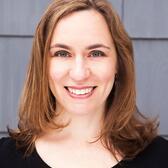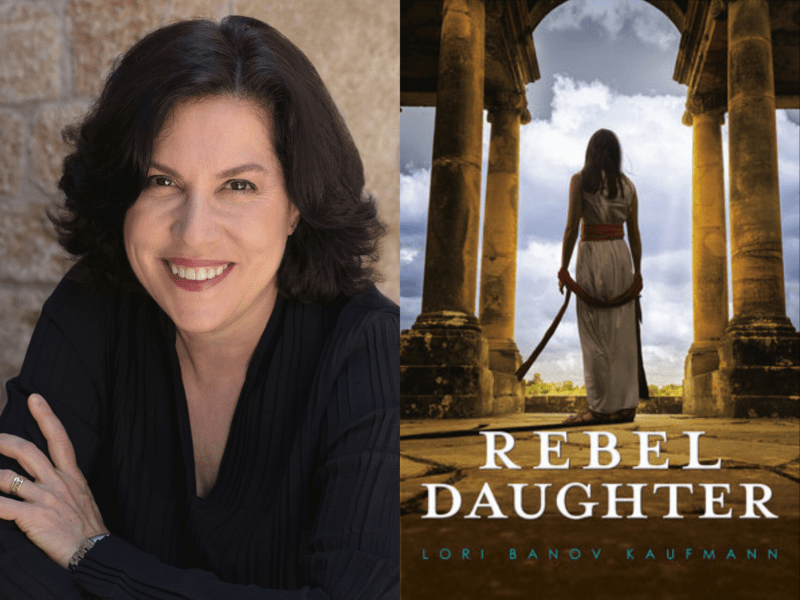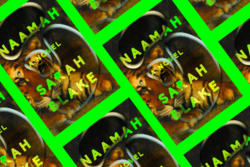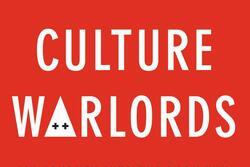Interview with Lori Banov Kaufmann, author of "Rebel Daughter"
Lori Banov Kaufmann, a former strategy consultant for high-tech companies, recently published her debut novel exploring the revolt against Rome and the destruction of Jerusalem in 70 CE, through the eyes of a young woman, Esther. JWA spoke with Lori about the inspiration for and process of creating this compelling tale of family, love, and resilience.
JWA: You’ve said that you were inspired to write Rebel Daughter when you learned about the historical evidence that became the basis for your main character, Esther. How did you discover the seed of this story and what inspired you to develop it into a novel?
LBK: The seed was planted in a random conversation in a Tel Aviv sushi restaurant more than twelve years ago! Professor Jonathan Price, chairman of the history department at Tel Aviv University, mentioned the discovery of a 2,000 year-old gravestone of a Jewish woman discovered near the Bay of Naples. The woman buried there, Esther, was taken captive after the fall of the Second Temple and sold as a slave in Rome. Her owner had erected the gravestone. I immediately wanted to know more!
Admittedly, what intrigued me was the implausible love story the epitaph revealed (no spoilers!). But I soon learned that there was much more behind the few Latin words chiseled into the stone than the story of one woman’s life. This was also the story of the Jewish people at a time when their very survival was at stake. Why would Judea, a small remote Roman province with no army, declare war on the greatest empire the world had ever known? Did they really believe they could defeat legions of fierce Roman soldiers? As soon as I answered one question, I had ten more.
And as they say, the rest is history (literally…)
JWA: How did you imagine your way into the mindset and experiences of Esther, a young girl in first century Jerusalem?
LBK: I love the way you framed this question as imagining your way into the characters because that’s exactly it. Before I could transport my readers back in time, I had to transport myself. I needed to walk in Esther’s shoes (or rather sandals); feel my eyes burning from the smoke of the sacrifices in the Temple and smell the spices in the market. I had to paint first century Jerusalem in enough detail to make it come alive. So, the setting was definitely first. I had to be there.
Next, I had to move from Esther’s outer world to her interior world. For any writer, inhabiting the minds and hearts of your characters requires a leap of faith that there are universal truths about human nature. And I do believe that these truths transcend time and place. Of course, I haven’t waited in dread for Roman soldiers to burst into my house, but I have sat in a bomb shelter waiting for the boom of the next Iraqi Scud missile, and I’ve waited for the surgeon to come out of the operating room. I’ve felt that excruciating feeling of powerlessness and fear in my bones. I know the exhilaration and confusion of first love. Esther’s desire to understand the world and to find her place—who can’t relate to that? It’s not only writers who imagine themselves into their characters; readers do, too.
JWA: The book comes alive with amazing details about daily life in the first century. What was your research process?
LBK: I’d say it was more of an obsession than a process! From the beginning I felt a tremendous obligation to my real-life characters and to my readers to tell the story as accurately as possible. I probably didn’t need to study the proceedings from a conference on first century garbage dumps or spend two weeks learning about ancient wine vats, but the precise details I learned give the story authenticity and credibility—and are probably why it took me ten years to write!
Since I live in Israel, I had access not only to the alleyways of the Old City of Jerusalem but also to the artifacts at the Israel Museum, archaeological sites all over the country, and world-class scholars at Hebrew University and Tel Aviv University. And of course, I read piles of books and dissertations. My primary source for the events of the period was the eyewitness account of the revolt from the ancient historian Josephus. And while not everything in the book actually happened, everything is historically plausible. In other words, it could have happened.
JWA: This is obviously a different angle on the history of the destruction of the Temple than we usually encounter. How do you think looking at this story through the eyes of a young woman’s experience changes our perspective on and understanding of history?
LBK: History gives us an intellectual understanding of events but doesn’t engage us emotionally the way fiction can. Moreover, we know that history is subjective. People who wrote about the events each had their own agendas. And even contemporary scholars trying to be objective necessarily filter the events through a twentieth century lens. But we rarely get to learn about history from the perspective of contemporaneous women, and I believe it’s an important one.
The late Rabbi Jonathan Sacks said history is what happened to other people, memory is your own story. And the destruction of the Second Temple has always been seared in the collective memory of the Jewish people. We’ve remembered it for twenty centuries, not only every year on Tisha B’Av, but when we wed and when we recite Psalm 137, “I will never forget you, O Jerusalem.” So, it’s not only Esther’s story, it’s our story, too.
JWA: In many obvious ways, Esther’s world is so different from our 21st century world. In what ways does this story speak to our own time? What can we learn from it?
LBK: The astute reader will have no trouble identifying some troubling parallels, even though that was not my goal. I just wanted to transport the reader back in time in a fast-paced and entertaining read. But readers do want to learn, to be challenged and to find meaning.
By entering this ancient world with empathy and curiosity, we see what can happen when religious fanaticism and aggressive nationalism go unchecked. We see how quickly dangerous ideologies can spread. We see how civil discord can lead to civil war. But we also see that we have to fight for what we believe in—freedom, human dignity, and justice. We see that love doesn’t always come in the form we expect. We see that even when the world as we know it is gone, there’s hope.
JWA: You’ve described yourself as “late bloomer” writer. How did you come to writing?
LBK: I’ve always wanted to be a writer and even published a book with my husband when we were in graduate school: The Boston Ice Cream Lover’s Guide. It never made it onto the bestseller list, but it was fun to research, and it did lead to landing a top agent and to another book contract. But in one of those “crossroads of life” moments, we took a different turn, made Aliyah and pursued careers in high-tech instead. It was only when I turned 50 that I decided to write Esther’s story. Little did I know it would take so long and I’d be a debut fiction author in my 60’s! Which goes to prove, I guess, that it’s never too late.







